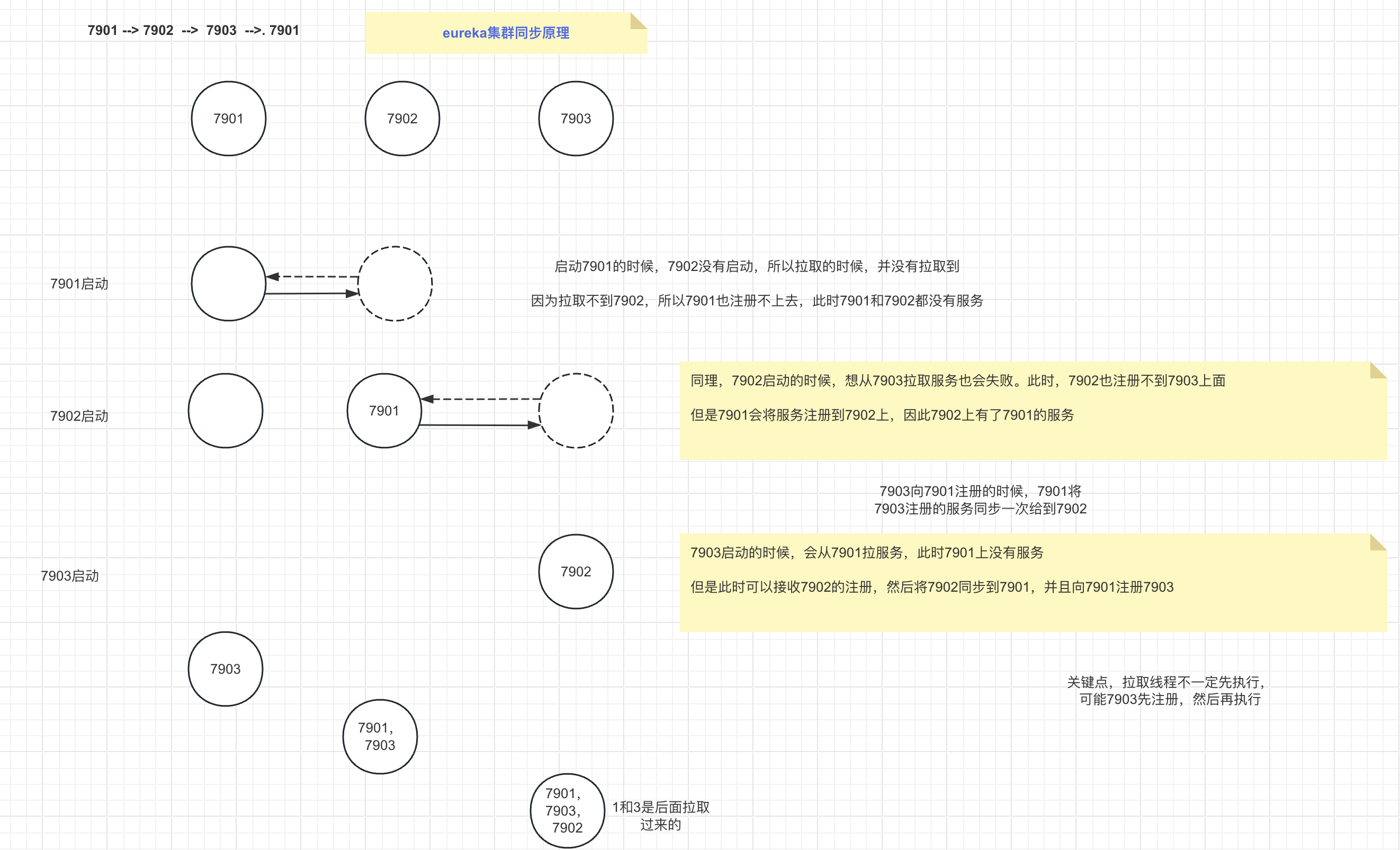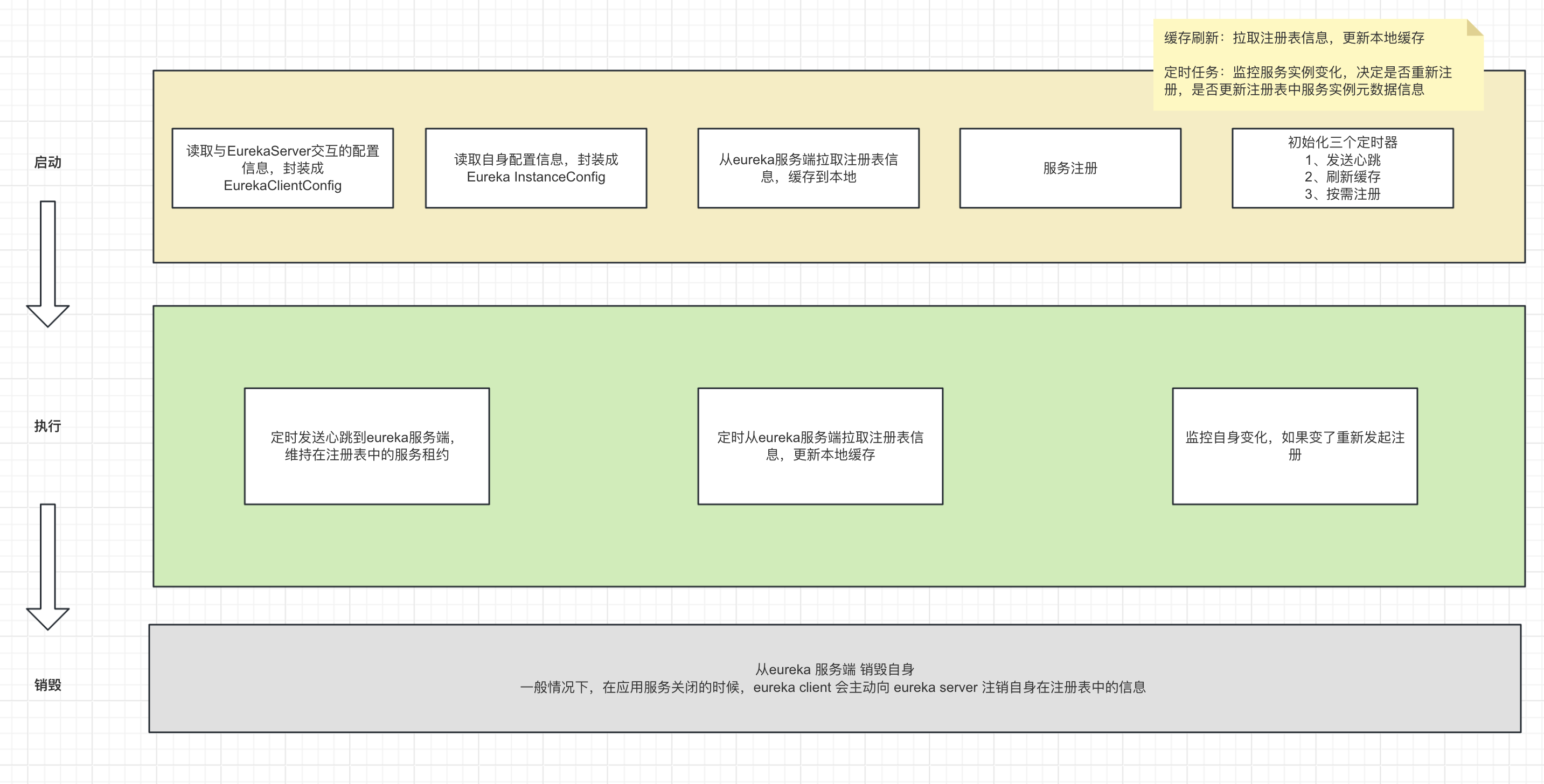微服务注册中心之Eureka
eureka 搭建集群
版本说明
Spring Boot 2.1.7.RELEASE
spring-cloud-starter-netflix-eureka-server Finchley.SR2
spring-boot-starter-security 2.1.7.RELEASE
pom.xml 文件
<?xml version="1.0" encoding="UTF-8"?><projectxmlns="http://maven.apache.org/POM/4.0.0"xmlns:xsi="http://www.w3.org/2001/XMLSchema-instance"xsi:schemaLocation="http://maven.apache.org/POM/4.0.0 https://maven.apache.org/xsd/maven-4.0.0.xsd"><modelVersion>4.0.0</modelVersion><parent><groupId>org.springframework.boot</groupId><artifactId>spring-boot-starter-parent</artifactId><version>2.1.7.RELEASE</version><relativePath/><!-- lookup parent from repository --></parent><groupId>com.online.taxi.eureka</groupId><artifactId>eureka</artifactId><version>0.0.1-SNAPSHOT</version><name>eureka</name><description>Demo project for Spring Boot</description><properties><project.build.sourceEncoding>UTF-8</project.build.sourceEncoding><project.reporting.outputEncoding>UTF-8</project.reporting.outputEncoding><java.version>1.8</java.version><spring-cloud.version>Finchley.SR2</spring-cloud.version></properties><dependencies><!-- eureka 服务端 --><dependency><groupId>org.springframework.cloud</groupId><artifactId>spring-cloud-starter-netflix-eureka-server</artifactId></dependency><!-- 安全认证 --><dependency><groupId>org.springframework.boot</groupId><artifactId></artifactId></dependency></dependencies><dependencyManagement><dependencies><dependency><groupId>org.springframework.cloud</groupId><artifactId>spring-cloud-dependencies</artifactId><version>${spring-cloud.version}</version><type>pom</type><scope>import</scope></dependency></dependencies></dependencyManagement></project>
搭建单节点
单节点搭建非常简单,引入上面的依赖,然后编写配置文件
application.yml
#单节点,正确#应用名称及验证账号server:port:7900spring:application:name: eureka
security:user:# eureka登陆账号密码name: root
password: root
eureka:client:register-with-eureka:falsefetch-registry:falseservice-url:defaultZone: http://root:root@localhost:7900/eureka/
server:#关闭自我保护enable-self-preservation:false#清理间隔时间eviction-interval-timer-in-ms:5000
启动类添加注解
importorg.springframework.boot.SpringApplication;importorg.springframework.boot.autoconfigure.SpringBootApplication;importorg.springframework.cloud.netflix.eureka.server.EnableEurekaServer;importcom.netflix.eureka.registry.InstanceRegistry;importcom.netflix.eureka.registry.PeerAwareInstanceRegistry;importcom.netflix.eureka.registry.PeerAwareInstanceRegistryImpl;@EnableEurekaServer// eureka服务端启动注解@SpringBootApplicationpublicclassEurekaApplication{publicstaticvoidmain(String[] args){SpringApplication.run(EurekaApplication.class, args);}}
这样单节点就构建完成了。
但是单节点一般来说仅仅是个人开发时使用,因为单节点容易出现问题,当该节点因为网络或者其他情况不可用时,其他服务之间的调用就会出现问题。
因此注册中心都是搭建集群来使用。
eureka集群搭建
pom文件启动类还是与单机时没有任何区别,唯有配置文件需要更改
为了演示,这里我们仅仅只建立一个项目,但是启动三次,模拟三个节点的高可用集群,配置文件如下
#高可用3个节点,正确。#应用名称及验证账号spring:application:name: eureka
security:user:name: root
password: root
logging:level:root: info
eureka:server:# 设置 eureka server同步失败的等待时间 默认 5分 , 在这期间,它不向客户端提供服务注册信息wait-time-in-ms-when-sync-empty:0client:serviceUrl:defaultZone: http://root:root@localhost:7901/eureka/,http://root:root@localhost:7902/eureka/,http://root:root@localhost:7903/eureka/
---spring:profiles:7901server:port:7901eureka:instance:hostname: eureka-7901---spring:profiles:7902server:port:7902eureka:instance:hostname: eureka-7902---spring:profiles:7903server:port:7903eureka:instance:hostname: eureka-7903
怎样在一个项目中启动三次服务,这个看截图
点击左上角的 “+” ,添加springboot启动项,Name是启动项名称,build and run 下,前者是jdk,后者选择服务启动类,最后在 Active profiles 分别填写对应的 profiles 即可

这样集群就搭建完成了
关闭csrf
需要注意的是,搭建集群时,若引入spring security后,需要关闭csrf,不然会一只报注册失败
关闭csrf代码如下
importorg.springframework.context.annotation.Configuration;importorg.springframework.security.config.annotation.web.builders.HttpSecurity;importorg.springframework.security.config.annotation.web.configuration.EnableWebSecurity;importorg.springframework.security.config.annotation.web.configuration.WebSecurityConfigurerAdapter;@Configuration@EnableWebSecuritypublicclassWebSecurityConfigextendsWebSecurityConfigurerAdapter{@Overrideprotectedvoidconfigure(HttpSecurity http)throwsException{// 关闭csrf// http.csrf().disable(); /*
* 默认情况下添加SpringSecurity依赖的应用每个请求都需要添加CSRF token才能访问,Eureka客户端注册时并不会添加,所以需要配置/eureka/**路径不需要CSRF token。
*/
http.csrf().ignoringAntMatchers("/eureka/**");// 开启认证支持HttpBasic
http.authorizeRequests().anyRequest().authenticated().and().httpBasic();}}
eureka 多节点注意事项
问题:eureka server间 设置peer。A->B,B->C,C->A,结果注册信息并不同步。
看例子:
依次启动7901,7902,7903。
启动成功,注册api-driver ->7901
发现只有7901和7902有 api-driver而 7903没有。
简单说:api-driver向 7901注册,7902将api-driver同步到7902,但是不会同步到7903。后面源码会讲到。
多节点建议:设置A->B,A->C其他类似。尽量不要跨 eureka节点。一对多,面面对到。
讲解下图。前置概念peer。清除流程。
功能点:
peer启动:
1、拉取它的peer的注册表。
2、把自己注册到peer上。
3、完成2之后,2中的peer会把它同步到,2中peer的peer。
eureka集群复制流程图

Eureka 原理
- 本质:存储了每个客户端的注册信息。EurekaClient从EurekaServer同步获取服务注册列表。通过一定的规则选择一个服务进行调用。
- Eureka架构图
Eureka架构图

- 详解
- 服务提供者:是一个eureka client,向Eureka Server注册和更新自己的信息,同时能从Eureka Server注册表中获取到其他服务的信息。
- 服务注册中心:提供服务注册和发现的功能。每个Eureka Cient向Eureka Server注册自己的信息,也可以通过Eureka Server获取到其他服务的信息达到发现和调用其他服务的目的。
- 服务消费者:是一个eureka client,通过Eureka Server获取注册到其上其他服务的信息,从而根据信息找到所需的服务发起远程调用。
- 同步复制:Eureka Server之间注册表信息的同步复制,使Eureka Server集群中不同注册表中服务实例信息保持一致。
- 远程调用:服务客户端之间的远程调用。
- 注册:Client端向Server端注册自身的元数据以供服务发现。
- 续约:通过发送心跳到Server以维持和更新注册表中服务实例元数据的有效性。当在一定时长内,Server没有收到Client的心跳信息,将默认服务下线,会把服务实例的信息从注册表中删除。
- 下线:Client在关闭时主动向Server注销服务实例元数据,这时Client的服务实例数据将从Server的注册表中删除。
- 获取注册表:Client向Server请求注册表信息,用于服务发现,从而发起服务间远程调用。
如果让我们自己做,该如何做 ?
客户端:
拉取注册表
从注册表选一个
调用
服务端:
写个web server。
功能:
1、定义注册表:
Map<name,Map<id,InstanceInfo>>。
2、别人可以向我注册自己的信息。
3、别人可以从我这里拉取他人的注册信息。
4、我和我的同类可以共享注册表。
eureka是用:jersey实现,也是个mvc框架。
我们可以自己写个spring boot web实现。
Eureka 源码
Eureka Client源码
- eureka 接口
https://github.com/Netflix/eureka/wiki/Eureka-REST-operations注意地址中的v2 是没有的。查询所有实例信息:http://localhost:7900/eureka/apps注册服务:http://localhost:7900/eureka/apps/{applicationName}
Eureka Client工作流程图

- 源码解读下面的讲解按照顺序进行。- spring boot项目引入eureka-client依赖,并注入spring 容器。在spring-boot项目中pom文件里面添加的依赖中的bean。是如何注册到spring-boot项目的spring容器中的呢?spring.factories文件是帮助spring-boot项目包以外的bean(即在pom文件中添加依赖中的bean)注册到spring-boot项目的spring容器的。由于@ComponentScan注解只能扫描spring-boot项目包内的bean并注册到spring容器中,因此需要@EnableAutoConfiguration(在SpringBootApplication下),注解来注册项目包外的bean。而spring.factories文件,则是用来记录项目包外需要注册的bean类名。点进去@SpringBootApplication注解,发现@EnableAutoConfiguration。点@EnableAutoConfiguration进去。
@Import(AutoConfigurationImportSelector.class)public @interface EnableAutoConfiguration {点AutoConfigurationImportSelector进去发现下面代码 @Override public String[] selectImports(AnnotationMetadata annotationMetadata){if(!isEnabled(annotationMetadata)){return NO_IMPORTS;} AutoConfigurationMetadata autoConfigurationMetadata = AutoConfigurationMetadataLoader .loadMetadata(this.beanClassLoader); AutoConfigurationEntry autoConfigurationEntry = getAutoConfigurationEntry(autoConfigurationMetadata, annotationMetadata);return StringUtils.toStringArray(autoConfigurationEntry.getConfigurations());}此方法时,向spring ioc容器注入bean。selectImports,返回bean全名。import将bean全名注入。而注入的bean都是些什么呢?点:getAutoConfigurationEntry进去,有一句List<String> configurations = getCandidateConfigurations(annotationMetadata, attributes);点getCandidateConfigurations进去:List<String> configurations = SpringFactoriesLoader.loadFactoryNames(getSpringFactoriesLoaderFactoryClass(), getBeanClassLoader());点SpringFactoriesLoader进去:public static final String FACTORIES_RESOURCE_LOCATION ="META-INF/spring.factories";
- 找eureka client 配置相关类
在api-listen-order(其他eureka client项目均可)项目中,找到spring-cloud-netflix-eureka-client-2.1.2.RELEASE下META-INF下spring.factories。此文件中,有如下配置信息:EurekaClientAutoConfiguration(Eureka client自动配置类,负责Eureka client中关键beans的配置和初始化),RibbonEurekaAutoConfiguration(Ribbon负载均衡相关配置) EurekaDiscoveryClientConfiguration(配置自动注册和应用的健康检查器)。 - EurekaDiscoveryClientConfiguration介绍
找到此类:org.springframework.cloud.netflix.eureka.EurekaDiscoveryClientConfiguration中的注解@ConditionalOnClass(EurekaClientConfig.class), - EurekaClientConfig介绍
点击进去查看EurekaClientConfig是个接口,查看其实现类EurekaClientConfigBean。此类里封装了Eureka Client和Eureka Server交互所需要的配置信息。看此类代码: public static final String PREFIX ="eureka.client"; 表示在配置文件中用eureka.client.属性名配置。 - Eureka 实例相关配置
从org.springframework.cloud.client.discovery.DiscoveryClient顶级接口入手,前面介绍过spring common。看其在Eureka中的实现类org.springframework.cloud.netflix.eureka.EurekaDiscoveryClient。有一个属性: private final EurekaClient eurekaClient,查看其实现类:com.netflix.discovery.DiscoveryClient。有一个属性: private final ApplicationInfoManager applicationInfoManager(应用信息管理器,点进去此类,发现此类总有两个属性: private InstanceInfo instanceInfo;private EurekaInstanceConfig config; 服务实例的信息类InstanceInfo和服务实例配置信息类EurekaInstanceConfig)。 - InstanceInfo介绍
打开InstanceInfo里面有instanceId等服务实例信息。 InstanceInfo封装了将被发送到Eureka Server进行注册的服务实例元数据。它在Eureka Server列表中代表一个服务实例,其他服务可以通过instanceInfo了解到该服务的实例相关信息,包括地址等,从而发起请求。 - EurekaInstanceConfig介绍
EurekaInstanceConfig是个接口,找到它的实现类org.springframework.cloud.netflix.eureka.EurekaInstanceConfigBean。 此类封装了EurekaClient自身服务实例的配置信息,主要用于构建InstanceInfo。看到此类有一段代码:@ConfigurationProperties("eureka.instance"), 在配置文件中用eureka.instance.属性配置。EurekaInstanceConfigBean提供了默认值。 - 通过EurekaInstanceConfig构建instanceInfo
在ApplicationInfoManager中有一个方法public void initComponent(EurekaInstanceConfig config)中有一句:this.instanceInfo = new EurekaConfigBasedInstanceInfoProvider(config).get();通过EurekaInstanceConfig构造instanceInfo。 - 顶级接口DiscoveryClient介绍
介绍一下spring-cloud-commons-2.2.1.realease包下,org.springframework.cloud.client.discovery.DiscoveryClient接口。定义用来服务发现的客户端接口,是客户端进行服务发现的核心接口,是spring cloud用来进行服务发现的顶级接口,在common中可以看到其地位。在Netflix Eureka和Consul中都有具体的实现类。org.springframework.cloud.client.discovery.DiscoveryClient的类注释: Represents read operations commonly available to discovery services such as Netflix Eureka or consul.io。 代表通用于服务发现的读操作,例如在 eureka或consul中。 有 String description();//获取实现类的描述。 List<String> getServices();//获取所有服务实例id。 List<ServiceInstance> getInstances(String serviceId);//通过服务id查询服务实例信息列表。 - Eureka 的实现
接下来我们找Eureka的实现类。org.springframework.cloud.netflix.eureka.EurekaDiscoveryClient。查看方法。public List<ServiceInstance> getInstances(String serviceId),组合了com.netflix.discovery.EurekaClient来实现。 - EurekaClient的实现
EurekaClient有一个注解@ImplementedBy(DiscoveryClient.class),此类的默认实现类:com.netflix.discovery.DiscoveryClient。提供了:服务注册到server方法register().续约boolean renew().下线public synchronized void shutdown().查询服务列表 功能。想想前面的图中client的功能。提供了于Eureka Server交互的关键逻辑。 - com.netflix.discovery.DiscoveryClient
com.netflix.discovery.DiscoveryClient实现了EurekaClient(继承了LookupService) - com.netflix.discovery.shared.LookupService
LookupService作用:发现活跃的服务实例。根据服务实例注册的appName来获取封装有相同appName的服务实例信息容器: Application getApplication(String appName)。获取所有的服务实例信息:Applications getApplications();根据实例id,获取服务实例信息:List<InstanceInfo> getInstancesById(String id);上面提到一个Application,它持有服务实例信息列表。它是同一个服务的集群信息。比如api-passenger的所有服务信息,这些服务都在api-passenger服务名下面。而instanceInfo代表一个服务实例的信息。为了保证原子性,比如对某个instanceInfo的操作,使用了大量同步的代码。比如下面代码:public void addInstance(InstanceInfo i) { instancesMap.put(i.getId(), i); synchronized (instances) { instances.remove(i); instances.add(i); isDirty = true; }}Applications是注册表中,所有服务实例信息的集合。 - 健康检测器和事件监听器
EurekaClient在LookupService上做了扩充。提供了更丰富的获取服务实例的方法。按住不表。我们看一下另外两个方法:public void registerHealthCheck(HealthCheckHandler healthCheckHandler),向client注册 健康检查处理器,client存在一个定时任务通过HealthCheckHandler检查当前client状态,当client状态发生变化时,将会触发新的注册事件,去更新eureka server的注册表中的服务实例信息。通过HealthCheckHandler 实现应用状态检测。HealthCheckHandler的实现类org.springframework.cloud.netflix.eureka.EurekaHealthCheckHandler,看其构造函数:public EurekaHealthCheckHandler(HealthAggregator healthAggregator) { Assert.notNull(healthAggregator, "HealthAggregator must not be null"); this.healthIndicator = new CompositeHealthIndicator(healthAggregator);}private final CompositeHealthIndicator healthIndicator;此类事属于org.springframework.boot.actuate.health包下,可以得出,是通过actuator来实现对应用的检测的。public void registerEventListener(EurekaEventListener eventListener)注册事件监听器,当实例信息有变时,触发对应的处理事件。 - 找到com.netflix.discovery.DiscoveryClient
在api-listen-order项目中,找到spring-cloud-netflix-eureka-client-2.1.2.RELEASE下META-INF下spring.factories。此文件中org.springframework.cloud.bootstrap.BootstrapConfiguration=\org.springframework.cloud.netflix.eureka.config.EurekaDiscoveryClientConfigServiceBootstrapConfiguration,此类有个注解:@Import({ EurekaDiscoveryClientConfiguration.class, // this emulates // @EnableDiscoveryClient, the import // selector doesn't run before the // bootstrap phase EurekaClientAutoConfiguration.class })注解中有个类: EurekaClientAutoConfiguration,此类中有如下代码:CloudEurekaClient cloudEurekaClient = new CloudEurekaClient(appManager, config, this.optionalArgs, this.context);(debug可以调试到)通过CloudEurekaClient找到:public class CloudEurekaClient extends DiscoveryClient。 - com.netflix.discovery.DiscoveryClient构造函数-不注册不拉取
DiscoveryClient的构造函数:DiscoveryClient(ApplicationInfoManager applicationInfoManager, EurekaClientConfig config, AbstractDiscoveryClientOptionalArgs args,Provider<BackupRegistry> backupRegistryProvider, EndpointRandomizer endpointRandomizer) 此方法中依次执行了 从eureka server中拉取注册表,服务注册,初始化发送心跳,缓存刷新(定时拉取注册表信息),按需注册定时任务等,贯穿了Eureka Client启动阶段的各项工作。构造函数353行:if (config.shouldFetchRegistry()) { this.registryStalenessMonitor = new ThresholdLevelsMetric(this, METRIC_REGISTRY_PREFIX + "lastUpdateSec_", new long[]{15L, 30L, 60L, 120L, 240L, 480L});} else { this.registryStalenessMonitor = ThresholdLevelsMetric.NO_OP_METRIC;} shouldFetchRegistry,点其实现类EurekaClientConfigBean,找到它其实对应于:eureka.client.fetch-register,true:表示client从server拉取注册表信息。下面:if (config.shouldRegisterWithEureka()) { this.heartbeatStalenessMonitor = new ThresholdLevelsMetric(this, METRIC_REGISTRATION_PREFIX + "lastHeartbeatSec_", new long[]{15L, 30L, 60L, 120L, 240L, 480L});} else { this.heartbeatStalenessMonitor = ThresholdLevelsMetric.NO_OP_METRIC;} shouldRegisterWithEureka,点其实现类EurekaClientConfigBean,找到它其实对应于: eureka.client.register-with-eureka:true:表示client将注册到server。 if (!config.shouldRegisterWithEureka() && !config.shouldFetchRegistry()) { 如果以上两个都为false,则直接返回,构造方法执行结束,既不服务注册,也不服务发现。 - com.netflix.discovery.DiscoveryClient构造函数-两个定时任务
顺着上面代码往下看: scheduler = Executors.newScheduledThreadPool(2, new ThreadFactoryBuilder() .setNameFormat("DiscoveryClient-%d") .setDaemon(true) .build()); 定义了一个基于线程池的定时器线程池,大小为2。 往下: heartbeatExecutor:用于发送心跳, cacheRefreshExecutor:用于刷新缓存。 - com.netflix.discovery.DiscoveryClient构造函数-client和server交互的Jersey客户端
接着构建eurekaTransport = new EurekaTransport();它是eureka Client和eureka server进行http交互jersey客户端。点开EurekaTransport,看到许多httpclient相关的属性。 - com.netflix.discovery.DiscoveryClient构造函数-拉取注册信息
if (clientConfig.shouldFetchRegistry() && !fetchRegistry(false)) { fetchRegistryFromBackup(); } 如果判断的前部分为true,执行后半部分fetchRegistry。此时会从eureka server拉取注册表中的信息,将注册表缓存到本地,可以就近获取其他服务信息,减少于server的交互。 - com.netflix.discovery.DiscoveryClient构造函数-服务注册
if (clientConfig.shouldRegisterWithEureka() && clientConfig.shouldEnforceRegistrationAtInit()) { try { if (!register() ) { throw new IllegalStateException("Registration error at startup. Invalid server response."); } } catch (Throwable th) { logger.error("Registration error at startup: {}", th.getMessage()); throw new IllegalStateException(th); } }注册失败抛异常。 - com.netflix.discovery.DiscoveryClient构造函数-启动定时任务
在构造方法的最后initScheduledTasks();此方法中,启动3个定时任务。方法内有statusChangeListener,按需注册是一个事件StatusChangeEvent,状态改变,则向server注册。 - com.netflix.discovery.DiscoveryClient构造函数-总结
总结DiscoveryClient构造关键过程: 初始化一堆信息。 从拉取注册表信息。 向server注册自己。 初始化3个任务。 详细后面继续讲。源码就是这样,得层层拨开。 - 拉取注册表信息详解
上面的fetchRegistry(false),点进去,看注释: // If the delta is disabled or if it is the first time, get all applications。 如果增量式拉取被禁止或第一次拉取注册表,则进行全量拉取:getAndStoreFullRegistry()。 否则进行增量拉取注册表信息getAndUpdateDelta(applications)。 一般情况,在Eureka client第一次启动,会进行全量拉取。之后的拉取都尽量尝试只进行增量拉取。 拉取服务注册表: 全量拉取:getAndStoreFullRegistry(); 增量拉取:getAndUpdateDelta(applications); - 全量拉取
进入getAndStoreFullRegistry() 方法,有一方法:eurekaTransport.queryClient.getApplications。 通过debug发现 实现类是AbstractJerseyEurekaHttpClient,点开,debug出 webResource地址为:http://root:root@eureka-7900:7900/eureka/apps/,此端点用于获取server中所有的注册表信息。 getAndStoreFullRegistry()可能被多个线程同时调用,导致新拉取的注册表被旧的覆盖(如果新拉取的动作设置apps阻塞的情况下)。 此时用了AutomicLong来进行版本管理,如果更新时版本不一致,不保存apps。 通过这个判断fetchRegistryGeneration.compareAndSet(currentUpdateGeneration, currentUpdateGeneration + 1),如果版本一致,并设置新版本(+1), 接着执行localRegionApps.set(this.filterAndShuffle(apps));过滤并洗牌apps。点开this.filterAndShuffle(apps)实现,继续点apps.shuffleAndIndexInstances,继续点shuffleInstances,继续点application.shuffleAndStoreInstances,继续点_shuffleAndStoreInstances,发现if (filterUpInstances && InstanceStatus.UP != instanceInfo.getStatus())。只保留状态为UP的服务。 - 增量拉取
回到刚才的fetchRegistry方法中,getAndUpdateDelta,增量拉取。通过getDelta方法,看到实际拉取的地址是:apps/delta,如果获取到的delta为空,则全量拉取。 通常来讲是3分钟之内注册表的信息变化(在server端判断),获取到delta后,会更新本地注册表。 增量式拉取是为了维护client和server端 注册表的一致性,防止本地数据过久,而失效,采用增量式拉取的方式,减少了client和server的通信量。 client有一个注册表缓存刷新定时器,专门负责维护两者之间的信息同步,但是当增量出现意外时,定时器将执行,全量拉取以更新本地缓存信息。更新本地注册表方法updateDelta,有一个细节。 if (ActionType.ADDED.equals(instance.getActionType())) ,public enum ActionType { ADDED, // Added in the discovery server MODIFIED, // Changed in the discovery server DELETED // Deleted from the discovery server }, 在InstanceInfo instance中有一个instance.getActionType(),ADDED和MODIFIED状态的将更新本地注册表applications.addApplication,DELETED将从本地剔除掉existingApp.removeInstance(instance)。 - 服务注册
好了拉取完eureka server中的注册表了,接着进行服务注册。回到DiscoveryClient构造函数。 拉取fetchRegistry完后进行register注册。由于构造函数开始时已经将服务实例元数据封装好了instanceInfo,所以此处之间向server发送instanceInfo, 通过方法httpResponse = eurekaTransport.registrationClient.register(instanceInfo);看到String urlPath = "apps/" + info.getAppName();又是一个server端点,退上去f7,httpResponse.getStatusCode() == Status.NO_CONTENT.getStatusCode();204状态码,则注册成功。 - 初始化3个定时任务
接着 // finally, init the schedule tasks (e.g. cluster resolvers, heartbeat, instanceInfo replicator, fetch initScheduledTasks();看注释初始化3个定时任务。 题外话: client会定时向server发送心跳,维持自己服务租约的有效性,用心跳定时任务实现; 而server中会有不同的服务实例注册进来,一进一出,就需要数据的同步。所以client需要定时从server拉取注册表信息,用缓存定时任务实现; client如果有变化,也会及时更新server中自己的信息,用按需注册定时任务实现。 就是这三个定时任务。 进 initScheduledTasks()方法中,clientConfig.shouldFetchRegistry(),从server拉取注册表信息。int registryFetchIntervalSeconds = clientConfig.getRegistryFetchIntervalSeconds()拉取的时间间隔,eureka.client.registry-fetch-interval-seconds进行设置。int renewalIntervalInSecs = nstanceInfo.getLeaseInfo().getRenewalIntervalInSecs();心跳定时器,默认30秒。心跳定时任务和缓存刷新定时任务是有scheduler 的 schedule提交的,鼠标放到scheduler上,看到一句话 A scheduler to be used for the following 3 tasks:- updating service urls- scheduling a TimedSuperVisorTask。知道循环逻辑是由TimedSuperVisorTask实现的。 new TimedSupervisorTask( "heartbeat", scheduler, heartbeatExecutor, renewalIntervalInSecs, TimeUnit.SECONDS, expBackOffBound, new HeartbeatThread()看到HeartbeatThread线程。点进去public void run() { if (renew()) { lastSuccessfulHeartbeatTimestamp = System.currentTimeMillis(); } } 里面是renew()方法。 scheduler.schedule( new TimedSupervisorTask( "cacheRefresh", scheduler, cacheRefreshExecutor, registryFetchIntervalSeconds, TimeUnit.SECONDS, expBackOffBound, new CacheRefreshThread() ), 看到CacheRefreshThread,进去,发现 class CacheRefreshThread implements Runnable { public void run() { refreshRegistry(); } }是用的refreshRegistry,进去发现fetchRegistry。回到原来讲过的地方。 boolean renew() { EurekaHttpResponse<InstanceInfo> httpResponse; try { httpResponse = eurekaTransport.registrationClient.sendHeartBeat(instanceInfo.getAppName(), instanceInfo.getId(), instanceInfo, null); logger.debug(PREFIX + "{} - Heartbeat status: {}", appPathIdentifier, httpResponse.getStatusCode()); if (httpResponse.getStatusCode() == Status.NOT_FOUND.getStatusCode()) { REREGISTER_COUNTER.increment(); logger.info(PREFIX + "{} - Re-registering apps/{}", appPathIdentifier, instanceInfo.getAppName()); long timestamp = instanceInfo.setIsDirtyWithTime(); boolean success = register(); if (success) { instanceInfo.unsetIsDirty(timestamp); } return success; } return httpResponse.getStatusCode() == Status.OK.getStatusCode(); } catch (Throwable e) { logger.error(PREFIX + "{} - was unable to send heartbeat!", appPathIdentifier, e); return false; } }看到如果遇到404,server没有此实例,则重新发起注册。如果续约成功返回 200. 点sendHeartBeat进去String urlPath = "apps/" + appName + '/' + id; 还有一个定时任务,按需注册。当instanceinfo和status发生变化时,需要向server同步,去更新自己在server中的实例信息。保证server注册表中服务实例信息的有效和可用。 // InstanceInfo replicator instanceInfoReplicator = new InstanceInfoReplicator( this, instanceInfo, clientConfig.getInstanceInfoReplicationIntervalSeconds(), 2); // burstSize statusChangeListener = new ApplicationInfoManager.StatusChangeListener() { @Override public String getId() { return "statusChangeListener"; } @Override public void notify(StatusChangeEvent statusChangeEvent) { if (InstanceStatus.DOWN == statusChangeEvent.getStatus() || InstanceStatus.DOWN == statusChangeEvent.getPreviousStatus()) { // log at warn level if DOWN was involved logger.warn("Saw local status change event {}", statusChangeEvent); } else { logger.info("Saw local status change event {}", statusChangeEvent); } instanceInfoReplicator.onDemandUpdate(); } }; if (clientConfig.shouldOnDemandUpdateStatusChange()) { applicationInfoManager.registerStatusChangeListener(statusChangeListener); } instanceInfoReplicator.start(clientConfig.getInitialInstanceInfoReplicationIntervalSeconds()); 此定时任务有2个部分, 1:定时刷新服务实例信息和检查应用状态的变化,在服务实例信息发生改变的情况下向server重新发起注册。InstanceInfoReplicator点进去。看到一个方法 public void run() { try { discoveryClient.refreshInstanceInfo();//刷新instanceinfo。 //如果实例信息有变,返回数据更新时间。 Long dirtyTimestamp = instanceInfo.isDirtyWithTime(); if (dirtyTimestamp != null) { discoveryClient.register();//注册服务实例。 instanceInfo.unsetIsDirty(dirtyTimestamp); } } catch (Throwable t) { logger.warn("There was a problem with the instance info replicator", t); } finally { //延时执行下一个检查任务。用于再次调用run方法,继续检查服务实例信息和状态的变化。 Future next = scheduler.schedule(this, replicationIntervalSeconds, TimeUnit.SECONDS); scheduledPeriodicRef.set(next); } } refreshInstanceInfo点进去,看方法注释:如果有变化,在下次心跳时,同步向server。2.注册状态改变监听器,在应用状态发生变化时,刷新服务实例信息,在服务实例信息发生改变时向server注册。 看这段 statusChangeListener = new ApplicationInfoManager.StatusChangeListener() { @Override public String getId() { return "statusChangeListener"; } @Override public void notify(StatusChangeEvent statusChangeEvent) { if (InstanceStatus.DOWN == statusChangeEvent.getStatus() || InstanceStatus.DOWN == statusChangeEvent.getPreviousStatus()) { // log at warn level if DOWN was involved logger.warn("Saw local status change event {}", statusChangeEvent); } else { logger.info("Saw local status change event {}", statusChangeEvent); } instanceInfoReplicator.onDemandUpdate(); } };如果状态发生改变,调用onDemandUpdate(),点onDemandUpdate进去,看到InstanceInfoReplicator.this.run(); 总结:两部分,一部分自己去检查,一部分等待状态监听事件。初始化定时任务完成,最后一步启动步骤完成。接下来就是正常服务于业务。然后消亡。 - 服务下线
服务下线:在应用关闭时,client会向server注销自己,在Discoveryclient销毁前,会执行下面清理方法。 @PreDestroy@Overridepublic synchronized void shutdown() ,看此方法上有一个注解,表示:在销毁前执行此方法。unregisterStatusChangeListener注销监听器。cancelScheduledTasks取消定时任务。unregister服务下线。eurekaTransport.shutdown关闭jersy客户端 等。unregister点进去。cancel点进去。AbstractJerseyEurekaHttpClient。String urlPath = "apps/" + appName + '/' + id;看到url和http请求delete方法。- client源码总结总结:源码其实两部分内容:1、client自身的操作。2、server的配合。(https://github.com/Netflix/eureka/wiki/Eureka-REST-operations)。 一切尽在:《Eureka Client工作流程图》
Eureka Server源码
- Eureka Server功能复习接受服务注册 接受服务心跳 服务剔除 服务下线 集群同步 获取注册表中服务实例信息
需要注意的是,Eureka Server同时也是一个Eureka Client,在不禁止Eureka Server的客户端行为时,它会向它配置文件中的其他Eureka Server进行拉取注册表、服务注册和发送心跳等操作。
- 源码解读- 启动server注册相关bean
注册外部的配置类spring-cloud-netflix-eureka-server-2.1.2.REALEASE.jar中META-INF/spring.factories中org.springframework.boot.autoconfigure.EnableAutoConfiguration=\ org.springframework.cloud.netflix.eureka.server.EurekaServerAutoConfiguration启动时会自动加载:EurekaServerAutoConfiguration功能:向spring的bean工厂添加eureka-server相关功能的bean。 但是EurekaServerAutoConfiguration的生效时有条件的。 EurekaServerAutoConfiguration上有一个注解:@ConditionalOnBean(EurekaServerMarkerConfiguration.Marker.class),意思是:只有在Spring容器里有Marker这个类的实例时,才会加载EurekaServerAutoConfiguration,这个就是控制是否开启Eureka Server的关键。- 开启eureka server开关:而在@EnableEurekaServer中,@Import(EurekaServerMarkerConfiguration.class),意思是:动态注入此bean到spring 容器。引入了EurekaServerMarkerConfiguration.class。所以开启了Server服务。所以注册了前面说的:EurekaServerAutoConfiguration- 开启注册在EurekaServerMarkerConfiguration上有@Import(EurekaServerInitializerConfiguration.class),导入了EurekaServerInitializerConfiguration,EurekaServerInitializerConfiguration implements ServletContextAware, SmartLifecycle,SmartLifecycle的作用是:初始化完之后,执行public void start()方法。
在public void start()中,启动一个线程。看注释:log.info(“Started Eureka Server”);发布事件:publish(new EurekaRegistryAvailableEvent(getEurekaServerConfig())),
告诉client,可以来注册了。
上面提到的 log.info("Started Eureka Server") 的上面一行。eurekaServerBootstrap.contextInitialized(EurekaServerInitializerConfiguration.this.servletContext);
点contextInitialized进去,看到initEurekaServerContext,初始化eureka 上下文,点initEurekaServerContext进去,看到
// Copy registry from neighboring eureka node
int registryCount = this.registry.syncUp();从相邻的eureka 节点复制注册表,
下一行openForTraffic(主要是和client 交换信息,traffic),查看实现,PeerAwareInstanceRegistryImpl,开启任务postInit,进去之后发现剔除功能(剔除 没有续约的服务)。postInit,点进去,发现new EvictionTask(),点进去,看到run方法中,evict(compensationTimeMs),点进去就到了,具体剔除逻辑,下面剔除的时候讲。
- PeerAwareInstanceRegistry接口
在EurekaServerAutoConfiguration中 有 public EurekaServerContext eurekaServerContext,中有DefaultEurekaServerContext,点进去找到
@PostConstruct
@Override
public void initialize() {
logger.info("Initializing ...");
peerEurekaNodes.start();
try {
registry.init(peerEurekaNodes);
} catch (Exception e) {
throw new RuntimeException(e);
}
logger.info("Initialized");
},其中peerEurekaNodes.start();启动一个只拥有一个线程的线程池,第一次进去会更新一下集群其他节点信息。registry.init(peerEurekaNodes);鼠标放在registry上,发现是PeerAwareInstanceRegistryImpl , 的 注册信息管理类里面的init方法。PeerAwareInstanceRegistry是个接口,实现类是:PeerAwareInstanceRegistryImpl。PeerAwareInstanceRegistry接口,实现了com.netflix.eureka.registry.InstanceRegistry。
- 服务实例注册表
Server是围绕注册表管理的。有两个InstanceRegistry。
com.netflix.eureka.registry.InstanceRegistry是euraka server中注册表管理的核心接口。职责是在内存中管理注册到Eureka Server中的服务实例信息。实现类有PeerAwareInstanceRegistryImpl。
org.springframework.cloud.netflix.eureka.server.InstanceRegistry对PeerAwareInstanceRegistryImpl进行了继承和扩展,使其适配Spring cloud的使用环境,主要的实现由PeerAwareInstanceRegistryImpl提供。
com.netflix.eureka.registry.InstanceRegistry extends LeaseManager<InstanceInfo>, LookupService<String> 。LeaseManager<InstanceInfo>是对注册到server中的服务实例租约进行管理。LookupService<String>是提供服务实例的检索查询功能。
LeaseManager<InstanceInfo>接口的作用是对注册到Eureka Server中的服务实例租约进行管理,方法有:服务注册,下线,续约,剔除。此接口管理的类目前是InstanceInfo。InstanceInfo代表服务实例信息。
PeerAwareInstanceRegistryImpl 增加了对peer节点的同步复制操作。使得eureka server集群中注册表信息保持一致。
- 接受服务注册
eureka服务端注册
我们学过Eureka Client在发起服务注册时会将自身的服务实例元数据封装在InstanceInfo中,然后将InstanceInfo发送到Eureka Server。Eureka Server在接收到Eureka Client发送的InstanceInfo后将会尝试将其放到本地注册表中以供其他Eureka Client进行服务发现。
我们学过:通过 eureka/apps/{服务名}注册
在EurekaServerAutoConfiguration中定义了 public FilterRegistrationBean jerseyFilterRegistration ,表名了 表明eureka-server使用了Jersey实现 对外的 restFull接口。注册一个 Jersey 的 filter ,配置好相应的Filter 和 url映射。
public javax.ws.rs.core.Application jerseyApplication(方法:中。
provider.addIncludeFilter(new AnnotationTypeFilter(Path.class));
provider.addIncludeFilter(new AnnotationTypeFilter(Provider.class));
添加一些过滤器,类似于过滤请求地址,Path类似于@RequestMapping,Provider类似于@Controller
在com.netflix.eureka.resources包下,是Eureka Server对于Eureka client的REST请求的定义。看ApplicationResource类(这是一类请求,应用类的请求),类似于应用@Controller注解:@Produces({"application/xml", "application/json"}),接受xml和json。见名识意 public Response addInstance。添加实例instanceinfo。 方法中,有一句:
registry.register(info, "true".equals(isReplication));鼠标放在registry上PeerAwareInstanceRegistry接口,点击void register方法。发现 是PeerAwareInstanceRegistryImpl 的方法:public void register(final InstanceInfo info, final boolean isReplication) ,中有一句:super.register(info, leaseDuration, isReplication);
进入下面正题:
com.netflix.eureka.registry.AbstractInstanceRegistry
register方法
在register中,服务实例的InstanceInfo保存在Lease中,Lease在AbstractInstanceRegistry中统一通过ConcurrentHashMap保存在内存中。在服务注册过程中,会先获取一个读锁,防止其他线程对registry注册表进行数据操作,避免数据的不一致。然后从resgitry查询对应的InstanceInfo租约是否已经存在注册表中,根据appName划分服务集群,使用InstanceId唯一标记服务实例。如果租约存在,比较两个租约中的InstanceInfo的最后更新时间lastDirtyTimestamp,保留时间戳大的服务实例信息InstanceInfo。如果租约不存在,意味这是一次全新的服务注册,将会进行自我保护的统计,创建新的租约保存InstanceInfo。接着将租约放到resgitry注册表中。
之后将进行一系列缓存操作并根据覆盖状态规则设置服务实例的状态,缓存操作包括将InstanceInfo加入用于统计Eureka Client增量式获取注册表信息的recentlyChangedQueue和失效responseCache中对应的缓存。最后设置服务实例租约的上线时间用于计算租约的有效时间,释放读锁并完成服务注册。
- 接受心跳 续租,renew
Eureka服务端接收心跳
在Eureka Client完成服务注册之后,它需要定时向Eureka Server发送心跳请求(默认30秒一次),维持自己在Eureka Server中租约的有效性。
看另一类请求com.netflix.eureka.resources.InstanceResource。下public Response renewLease(方法。看到一行boolean isSuccess = registry.renew(app.getName(), id, isFromReplicaNode);
点击renew的实现。
进入下面正题:
Eureka Server处理心跳请求的核心逻辑位于AbstractInstanceRegistry#renew方法中。renew方法是对Eureka Client位于注册表中的租约的续租操作,不像register方法需要服务实例信息,仅根据服务实例的服务名和服务实例id即可更新对应租约的有效时间。
com.netflix.eureka.registry.AbstractInstanceRegistry
renew
//根据appName获取服务集群的租约集合
Map<String, Lease<InstanceInfo>> gMap = registry.get(appName);
//查看服务实例状态
InstanceStatus overriddenInstanceStatus = this.getOverriddenInstanceStatus(
instanceInfo, leaseToRenew, isReplication);
if (overriddenInstanceStatus == InstanceStatus.UNKNOWN) {
//统计每分钟续租次数
renewsLastMin.increment();
//更新租约
leaseToRenew.renew();
此方法中不关注InstanceInfo,仅关注于租约本身以及租约的服务实例状态。如果根据服务实例的appName和instanceInfoId查询出服务实例的租约,并且根据#getOverriddenInstanceStatus方法得到的instanceStatus不为InstanceStatus.UNKNOWN,那么更新租约中的有效时间,即更新租约Lease中的lastUpdateTimestamp,达到续约的目的;如果租约不存在,那么返回续租失败的结果。
- 服务剔除
如果Eureka Client在注册后,既没有续约,也没有下线(服务崩溃或者网络异常等原因),那么服务的状态就处于不可知的状态,不能保证能够从该服务实例中获取到回馈,所以需要服务剔除此方法定时清理这些不稳定的服务,该方法会批量将注册表中所有过期租约剔除。
剔除是定时任务,默认60秒执行一次。延时60秒,间隔60秒
evictionTimer.schedule(evictionTaskRef.get(),
serverConfig.getEvictionIntervalTimerInMs(),
serverConfig.getEvictionIntervalTimerInMs());
从上面eureka server启动来看,剔除的任务,是线程启动的,执行的是下面的方法。
com.netflix.eureka.registry.AbstractInstanceRegistry
evict
判断是否开启自我保护
if (!isLeaseExpirationEnabled()) {
如果开启自我保护,不剔除。点进去isLeaseExpirationEnabled,查看实现类,有一个isSelfPreservationModeEnabled,点进去 @Override
public boolean isSelfPreservationModeEnabled() {
return serverConfig.shouldEnableSelfPreservation();
},发现EurekaServerConfig,的方法shouldEnableSelfPreservation,看其实现中有EurekaServerConfigBean,发现属性:enableSelfPreservation。
紧接着一个大的for循环,便利注册表register,依次判断租约是否过期。一次性获取所有的过期租约。
//获取注册表租约总数
int registrySize = (int) getLocalRegistrySize();
计算注册表租约的阈值 (总数乘以 续租百分比),得出要续租的数量
int registrySizeThreshold = (int) (registrySize * serverConfig.getRenewalPercentThreshold());
总数减去要续租的数量,就是理论要剔除的数量
int evictionLimit = registrySize - registrySizeThreshold;
//求 上面理论剔除数量,和过期租约总数的最小值。就是最终要提出的数量。
int toEvict = Math.min(expiredLeases.size(), evictionLimit);
然后剔除。用internalCancel(appName, id, false);执行 服务下线将服务从注册表清除掉。
剔除的限制:
1.自我保护期间不清除。
2.分批次清除。
3.服务是逐个随机剔除,剔除均匀分布在所有应用中,防止在同一时间内同一服务集群中的服务全部过期被剔除,造成在大量剔除服务时,并在进行自我保护时,促使程序崩溃。
EurekaServerInitializerConfiguration的 eurekaServerBootstrap.contextInitialized(方法,中initEurekaServerContext();点进去this.registry.openForTraffic(this.applicationInfoManager, registryCount);点进去,super.postInit();点进去evictionTaskRef.set(new EvictionTask());
evictionTimer.schedule(evictionTaskRef.get(),
serverConfig.getEvictionIntervalTimerInMs(),
serverConfig.getEvictionIntervalTimerInMs());
发现 定时任务。
剔除服务是个定时任务,用EvictionTask执行,默认60秒执行一次,延时60秒执行。定时剔除过期服务。
服务剔除将会遍历registry注册表,找出其中所有的过期租约,然后根据配置文件中续租百分比阀值和当前注册表的租约总数量计算出最大允许的剔除租约的数量(当前注册表中租约总数量减去当前注册表租约阀值),分批次剔除过期的服务实例租约。对过期的服务实例租约调用AbstractInstanceRegistry#internalCancel服务下线的方法将其从注册表中清除掉。
自我保护机制主要在Eureka Client和Eureka Server之间存在网络分区的情况下发挥保护作用,在服务器端和客户端都有对应实现。假设在某种特定的情况下(如网络故障),Eureka Client和Eureka Server无法进行通信,此时Eureka Client无法向Eureka Server发起注册和续约请求,Eureka Server中就可能因注册表中的服务实例租约出现大量过期而面临被剔除的危险,然而此时的Eureka Client可能是处于健康状态的(可接受服务访问),如果直接将注册表中大量过期的服务实例租约剔除显然是不合理的。
针对这种情况,Eureka设计了“自我保护机制”。在Eureka Server处,如果出现大量的服务实例过期被剔除的现象,那么该Server节点将进入自我保护模式,保护注册表中的信息不再被剔除,在通信稳定后再退出该模式;在Eureka Client处,如果向Eureka Server注册失败,将快速超时并尝试与其他的Eureka Server进行通信。“自我保护机制”的设计大大提高了Eureka的可用性。
- 服务下线
Eureka服务下线
Eureka Client在应用销毁时,会向Eureka Server发送服务下线请求,清除注册表中关于本应用的租约,避免无效的服务调用。在服务剔除的过程中,也是通过服务下线的逻辑完成对单个服务实例过期租约的清除工作。
在InstanceResource中, public Response cancelLease(
@HeaderParam(PeerEurekaNode.HEADER_REPLICATION) String isReplication)
一行代码:boolean isSuccess = registry.cancel(app.getName(), id,
"true".equals(isReplication));点进去cancel,发现:internalCancel(appName, id, isReplication); 查看实现:
先获取读锁,防止被其他线程修改
read.lock();
根据appName获取服务实力集群。
Map<String, Lease<InstanceInfo>> gMap = registry.get(appName);
在内存中取消实例 id的服务
if (gMap != null) {
leaseToCancel = gMap.remove(id);
}
添加到最近下线服务的统计队列
synchronized (recentCanceledQueue) {
recentCanceledQueue.add(new Pair<Long, String>(System.currentTimeMillis(), appName + "(" + id + ")"));
}
往下判断leaseToCancel是否为空,租约不存在,返回false,
如果存在,
设置租约下线时间。 leaseToCancel.cancel();
InstanceInfo instanceInfo = leaseToCancel.getHolder();
获取持有租约的服务信息,标记服务实例为instanceInfo.setActionType(ActionType.DELETED);
添加到租约变更记录队列
recentlyChangedQueue.add(new RecentlyChangedItem(leaseToCancel));用于eureka client的增量拉取注册表信息。
释放锁。
首先通过registry根据服务名和服务实例id查询关于服务实例的租约Lease是否存在,统计最近请求下线的服务实例用于Eureka Server主页展示。如果租约不存在,返回下线失败;如果租约存在,从registry注册表中移除,设置租约的下线时间,同时在最近租约变更记录队列中添加新的下线记录,以用于Eureka Client的增量式获取注册表信息。
- 集群同步
如果Eureka Server是通过集群的方式进行部署,那么为了维护整个集群中Eureka Server注册表数据的一致性,势必需要一个机制同步Eureka Server集群中的注册表数据。
Eureka Server集群同步包含两个部分,
一部分是Eureka Server在启动过程中从它的peer节点中拉取注册表信息,并将这些服务实例的信息注册到本地注册表中;
另一部分是Eureka Server每次对本地注册表进行操作时,同时会将操作同步到它的peer节点中,达到集群注册表数据统一的目的。
1.启动拉取别的peer
在Eureka Server启动类中:EurekaServerInitializerConfiguration位于EurekaServerAutoConfiguration 的import注解中。一行:eurekaServerBootstrap.contextInitialized(
进去:initEurekaServerContext();,点进去,一行:int registryCount = this.registry.syncUp();
看注释:拉取注册表从邻近节点。点击syncUp()的实现方法进去:
看循环:意思是,如果是i第一次进来,为0,不够等待的代码,直接执行下面的拉取服务实例。
将自己作为一个eureka client,拉取注册表。并通过register(instance, instance.getLeaseInfo().getDurationInSecs(), true)注册到自身的注册表中。
Eureka Server也是一个Eureka Client,在启动的时候也会进行DiscoveryClient的初始化,会从其对应的Eureka Server中拉取全量的注册表信息。在Eureka Server集群部署的情况下,Eureka Server从它的peer节点中拉取到注册表信息后,将遍历这个Applications,将所有的服务实例通过AbstractRegistry#register方法注册到自身注册表中。
int registryCount = this.registry.syncUp();
this.registry.openForTraffic(this.applicationInfoManager, registryCount);
当执行完上面的syncUp逻辑后,在下面的openForTraffic,开启此server接受别的client注册,拉取注册表等操作。而在它首次拉取其他peer节点时,是不允许client的通信请求的。
在openForTraffic中,初始化期望client发送过来的服务数量,即上面获取到的服务数量this.expectedNumberOfClientsSendingRenews = count;
updateRenewsPerMinThreshold点进去,是计算自我保护的统计参数:
this.numberOfRenewsPerMinThreshold = (int) (this.expectedNumberOfClientsSendingRenews
* (60.0 / serverConfig.getExpectedClientRenewalIntervalSeconds())
* serverConfig.getRenewalPercentThreshold());
服务数*(每个服务每分钟续约次数)*阈值
if (count > 0) {
this.peerInstancesTransferEmptyOnStartup = false;
}
如果count=0,没有拉取到注册表信息,将此值设为true,表示其他peer来取空的实例信息,意味着,将不允许client从此server获取注册表信息。如果count>0,将此值设置为false,允许client来获取注册表。
后面将服务置为上线,并开启剔除的定时任务。
当Server的状态不为UP时,将拒绝所有的请求。在Client请求获取注册表信息时,Server会判断此时是否允许获取注册表中的信息。上述做法是为了避免Eureka Server在#syncUp方法中没有获取到任何服务实例信息时(Eureka Server集群部署的情况下),Eureka Server注册表中的信息影响到Eureka Client缓存的注册表中的信息。因为是全量同步,如果server什么也没同步过来,会导致client清空注册表。导致服务调用出问题。
2.Server之间注册表信息的同步复制
为了保证Eureka Server集群运行时注册表信息的一致性,每个Eureka Server在对本地注册表进行管理操作时,会将相应的操作同步到所有peer节点中。
在外部调用server的restful方法时,在com.netflix.eureka.resources包下的ApplicationResource资源中,查看每个服务的操作。比如服务注册public Response addInstance(,此方法中有
registry.register(info, “true”.equals(isReplication));点进去实现类:replicateToPeers(Action.Register, info.getAppName(), info.getId(), info, null, isReplication);这是一种情况。
在PeerAwareInstanceRegistryImpl类中,看其他操作,cancel,renew等中都有replicateToPeers,
此方法中有个peerEurekaNodes,代表一个可同步数据的eureka Server的集合,如果注册表有变化,向此中的peer节点同步。
replicateToPeers方法,它将遍历Eureka Server中peer节点,向每个peer节点发送同步请求。
for (final PeerEurekaNode node : peerEurekaNodes.getPeerEurekaNodes()) {
// If the url represents this host, do not replicate to yourself.
if (peerEurekaNodes.isThisMyUrl(node.getServiceUrl())) {
continue;
}
replicateInstanceActionsToPeers(action, appName, id, info, newStatus, node);
}
此replicateInstanceActionsToPeers方法中,类PeerEurekaNode的实例node的各种方法,cancel,register,等,用了batchingDispatcher.process(,作用是将同一时间段内,相同服务实例的相同操作将使用相同的任务编号,在进行同步复制的时候,将根据任务编号合并操作,减少同步操作的数量和网络消耗,但是同时也造成了同步复制的延时性,不满足CAP中的C(强一致性)。
所以Eureka,只满足AP。
通过Eureka Server在启动过程中初始化本地注册表信息和Eureka Server集群间的同步复制操作,最终达到了集群中Eureka Server注册表信息一致的目的。
- 获取注册表中服务实例信息
Eureka Server中获取注册表的服务实例信息主要通过两个方法实现:AbstractInstanceRegistry#getApplicationsFromMultipleRegions从多地区获取全量注册表数据,AbstractInstanceRegistry#getApplicationDeltasFromMultipleRegions从多地区获取增量式注册表数据。
1、全量:
上面讲到从节点复制注册信息的时候,用方法public int syncUp() ,一行Applications apps = eurekaClient.getApplications();点进去实现类,有一行getApplicationsFromAllRemoteRegions(); 下面getApplicationsFromMultipleRegions,作用从多个地区中获取全量注册表信息,并封装成Applications返回,它首先会将本地注册表registry中的所有服务实例信息提取出来封装到Applications中,再根据是否需要拉取Region的注册信息,将远程拉取过来的Application放到上面的Applications中。最后得到一个全量的Applications。
2、在前面提到接受服务注册,接受心跳等方法中,都有recentlyChangedQueue.add(new RecentlyChangedItem(lease));作用是将新变动的服务放到最近变化的服务实例信息队列中,用于记录增量是注册表信息。getApplicationDeltasFromMultipleRegions,实现了从远处eureka server中获取增量式注册表信息的能力。
在EurekaServer对外restful中,在com.netflix.eureka.resources下,
@GET
public Response getApplication(@PathParam("version") String version,
@HeaderParam("Accept") final String acceptHeader,
@HeaderParam(EurekaAccept.HTTP_X_EUREKA_ACCEPT) String eurekaAccept) {
其中有一句:String payLoad = responseCache.get(cacheKey);在responseCache初始化的时候,它的构造方法ResponseCacheImpl(EurekaServerConfig serverConfig, ServerCodecs serverCodecs, AbstractInstanceRegistry registry) {中,Value value = generatePayload(key);点进去有一句:registry.getApplicationDeltasFromMultipleRegions(key.getRegions()));从远程获取delta增量注册信息。但是这个只是向client提供,不向server提供,因为server可以通过每次变更自动同步到peer。
获取增量式注册表信息将会从recentlyChangedQueue中获取最近变化的服务实例信息。recentlyChangedQueue中统计了近3分钟内进行注册、修改和剔除的服务实例信息,在服务注册AbstractInstanceRegistry#registry、接受心跳请求AbstractInstanceRegistry#renew和服务下线AbstractInstanceRegistry#internalCancel等方法中均可见到recentlyChangedQueue对这些服务实例进行登记,用于记录增量式注册表信息。#getApplicationsFromMultipleRegions方法同样提供了从远程Region的Eureka Server获取增量式注册表信息的能力。
最后说一句(求关注,求赞,别白嫖我)
最近无意间获得一份阿里大佬写的刷题笔记和面经,一下子打通了我的任督二脉,进大厂原来没那么难。
这是大佬写的, 7701页的阿里大佬写的刷题笔记,让我offer拿到手软
求一键三连:点赞、分享、收藏
点赞对我真的非常重要!在线求赞,加个关注我会非常感激!@小郑聊编程
版权归原作者 小郑说编程i 所有, 如有侵权,请联系我们删除。